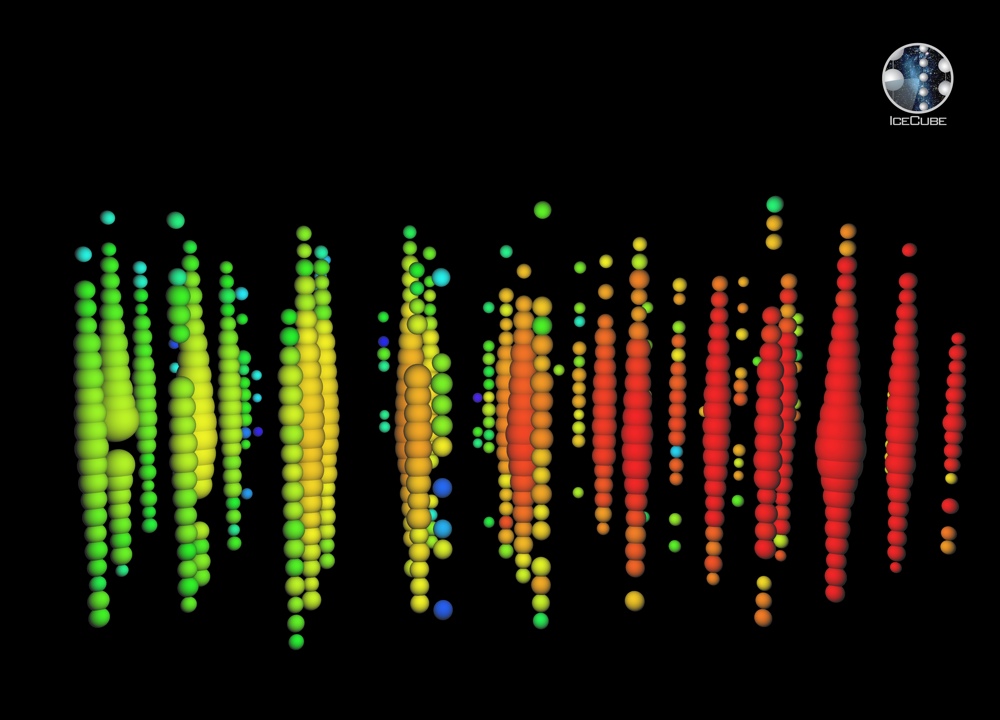Ghostly Particles from Outer Space Detected in Antarctica

Buried deep in the Antarctic ice, an observatory has spotted ghostly, nearly massless particles coming from inside our galaxy and points beyond the Milky Way.
Finding these cosmic neutrinos not only confirms their existence but also sheds light on the origins of cosmic rays, the researchers said.
The IceCube Neutrino Observatory is made up of 86 shafts dug 8,000 feet into the ice near the South Pole. The shafts are equipped with detectors that look for the telltale light from high-energy particles plowing through the surrounding ice. [See Photos of the IceCube Observatory Buried in Ice]
Neutrinos have little mass, and zip through matter so easily that a block of lead a light-year across wouldn't stop them. These elusive particles come from high-energy sources: exploding stars, black holes and galactic cores among them.
Though they don't interact much with matter, occasionally one will hit an atomic nucleus on Earth. When that happens the neutrino generates a particle called a muon. That's what scientists look for when seeking neutrinos — the muons move faster than the speed of light in a solid (ice in this case) and generate light waves, like the wake of a boat in water, called Cherenkov radiation. They also show the paths of the neutrinos. (The speed of light is constant in a vacuum, but it is slower in a medium like ice or glass — this is what causes refraction. So the muons aren't actually breaking the speed of light limit).
The IceCube project found neutrinos from outside our galaxy in 2013, but to confirm that detection the researchers, led by a team at the University of Wisconsin-Madison, had to make sure these neutrinos weren't coming from sources within our own galaxy (such as from the sun). To do so, they looked for neutrinos with similar energies that were coming from all directions at the same rate, meaning they are independent of the Earth's rotation and orbit around the sun — the only way that can happen is if the source is outside the galaxy.
The scientists also had to filter out muons created when cosmic rays crash into the planet's atmosphere. They used the Earth itself to weed out most of these muons, pointing the observatory through the Earth and toward the sky in the Northern Hemisphere (which is "down" with respect to Antarctica).
Get the world’s most fascinating discoveries delivered straight to your inbox.
Over two years, between May 2010 and May 2012, the observatory logged more than 35,000 neutrinos, with 20 of those showing high enough energies to suggest they came from cosmic sources.
Those 20 neutrinos, called muon neutrinos, came from the opposite direction, but at approximately the same rate, as similar neutrinos observed in earlier runs. Since the rate at which they showed up was about the same throughout the observation, it means it didn't matter where the observatory was pointed as a result of the daily rotation and yearly orbit of the Earth — the result predicted for extragalactic neutrinos. [Wacky Physics: The Coolest Little Particles in Nature]
"At least a fraction of that flux is extragalactic origin," Albrecht Karle, a UW-Madison professor of physics and one of the senior authors of the new study, told Live Science. "This was a new discovery."
Those observations also told them something else: The energies of the muon neutrinos, and their numbers, didn't fit well with several models of their origins. The scientists don't address it deeply in their study ("We leave that to theorists," Karle said), but the data appear to show these muon neutrinos are probably not coming from gamma-ray bursts (GRBs), which are highly energetic events in space.
"There are some stringent upper limits of neutrinos from GRBs — we know they don't produce that many," he said.
Similarly, active galactic nuclei don't seem to be the culprit, either, though Karle said it's too soon to say for sure.
Other possibilities are galaxies going through bouts of rapid star formation, or masses of gas and dust that surround black holes at the galactic centers. As atoms get pulled into the maw of a black hole, they slam into each other more often at higher energies. Eventually some produce pions, neutrinos and photons. If that were the case, Karle said, then one would expect a nearly one-to-one ratio of high-energy neutrinos to accompanying photons. But that hasn't been confirmed or refuted yet.
The study is detailed in today's (Aug. 20) issue of the journal Physical Review Letters.
Follow us @livescience, Facebook & Google+. Original article on Live Science.




